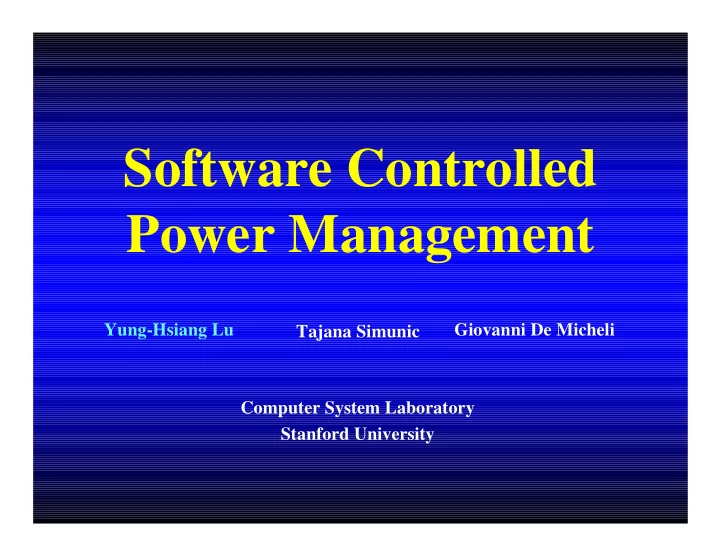

Software Controlled Power Management Yung-Hsiang Lu Giovanni De Micheli Tajana Simunic Computer System Laboratory Stanford University
Outline • Dynamic Power Management (DPM) • ACPI (Advanced Configuration & Power Interface) • Software Architecture • Experimental Result • Conclusion Stanford University CODES 99 Rome, Italy 2
Power State Transitions (Hard Disk) read / write Working Idle (spinning + IO) (spinning) IO complete read / write shut down spin up Sleeping (stop spinning) Stanford University CODES 99 Rome, Italy 3
Dynamic Power Management Shutdown a device when it is not used. Request and device modeling Applications: Management algorithms computers Power and performance tradeoffs embedded systems Implementation portable devices Power Manager & evaluation ….. request power state parameters model commands requests Workload Devices Stanford University CODES 99 Rome, Italy 4
DPM is a Co-Design Issue • HW provides multiple power states – allowing dynamic power state change – providing low state-transition overhead • SW implements DPM algorithms – implementing adaptive, flexible, smart algorithms – using higher-level information Stanford University CODES 99 Rome, Italy 5
Our Goal Build a framework to facilitate the design and evaluation of DPM algorithms on realistic workloads. • personal computer • commercial OS • real applications Stanford University CODES 99 Rome, Italy 6
ACPI Architecture Applications Applications Kernel Kernel Power Management Power Management Device ACPI driver Device ACPI driver Driver Driver AML interpreter AML interpreter OS OS ACPI ACPI Register Register Table Table BIOS BIOS interface interface interface interface interface interface ACPI Tables ACPI BIOS ACPI registers ACPI Tables ACPI BIOS ACPI registers Platform Hardware Platform Hardware BIOS BIOS Motherboard Motherboard Chipset CPU Chipset CPU devices devices Stanford University CODES 99 Rome, Italy 7
Software Architecture applications requests operating system power manager power manager device-specific driver ACPI hardware devices Stanford University CODES 99 Rome, Italy 8
Our Software Architecture applications Experiment DPM requests power manager Algorithms command utilization operating system power manager power manager filter driver device-specific driver ACPI hardware devices Stanford University CODES 99 Rome, Italy 9
Advantages • Separate policy and mechanism • Facilitate algorithm implementation & evaluation • Achieve high-precision performance analysis (microsecond) Stanford University CODES 99 Rome, Italy 10
Programming Interface Power Manager Requests Arrive SetPowerState Filter Driver synchronization observing IO activities, creating power command power state change…. timing analysis Stanford University CODES 99 Rome, Italy 11
Experiment Environment • Intel Pentium II-266 MHz • Windows NT 5 beta-2 • 256 MB RAM • IBM Deskstar IDE HDD – 3 power states – idle power 3.48 W – sleeping power 0.75 W – 7.2 sec / 52 J to wake up and 0.51 sec to sleep Stanford University CODES 99 Rome, Italy 12
Hard Disk State Transitions read / write working idle IO complete shut down read / write wake up sleeping time sleeping × Power sleeping + time idle × Power idle Total Energy = + # wakeups × Energy wakeup Stanford University CODES 99 Rome, Italy 13
Power vs. Timeout 2.4 2.2 Power (W) 2 1.8 1.6 0 30 60 90 120 150 180 Timeout (sec) Stanford University CODES 99 Rome, Italy 14
Power vs. Timeout 2.4 2.2 Power (W) 2 1.8 1.6 0 30 60 90 120 150 180 Timeout (sec) Adaptive timeout [Lu GLSVLSI 99]: 1.60 W Stanford University CODES 99 Rome, Italy 15
# shutdowns 120 90 # shutdown 60 30 0 0 30 60 90 120 150 180 Timeout (sec) Stanford University CODES 99 Rome, Italy 16
% Waiting for Spinning Up 10% 8% Waiting 6% 4% 2% 0% 0 30 60 90 120 150 180 Timeout (sec) Stanford University CODES 99 Rome, Italy 17
Conclusion • DPM is a HW/SW collaborative approach for reducing power. • We built a software architecture that – is portable – facilitates DPM algorithm evaluation – runs realistic workloads Stanford University CODES 99 Rome, Italy 18
Acknowledgements • MARCO / SIA • Patrick Burke and Charles Orgish (Stanford) • Luca Benini and Alessandro Bogliolo (Bologna) Stanford University CODES 99 Rome, Italy 19
Recommend
More recommend